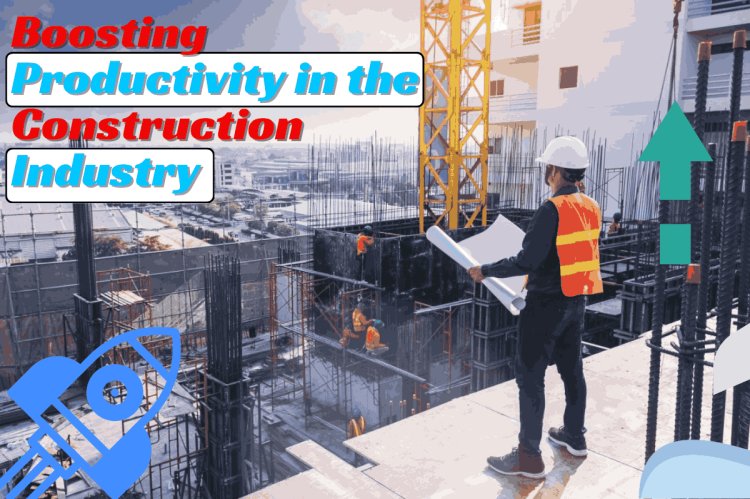Boosting Productivity in the Construction Industry
The construction industry is at the core of the economic life of any society, having a vital role in the development ranging from building homes, and infrastructure, to commercial structures. However, despite its significance, the industry has long grappled with challenges related to productivity efficiency, product quality, and project delivery timelines. In recent years, there has been a growing realization of the issues faced by this industry, and the need to introduce innovative solutions to boost productivity is widely recognized. This article will reflect on the challenges faced by the industry and the innovative solutions adopted worldwide to tackle them.

Understanding Productivity Challenges
Productivity in the construction sector is affected by various factors including labor shortage, lack of skilled labor, outdated construction methods, lack of proper supervision, lack of proper training to withstand risks, lack of efficient project management skills, and inadequate utilization of technology among many.
The shortage of skilled labor is responsible for delayed project completion with increased labor costs and quality control issues where aging labor adds oil to the fire and further exacerbates the problem.
Moreover, reliance on old methods of documentation where most of the work is paper-based which is prone to error, increases the inefficiencies. The lack of coordination among stakeholders is either due to a lack of understanding of their role or the significance of coordination or due communication breakdowns can further impede the progress and productivity. Additionally, the reliance on outdated construction methods and nearly no evolution in the techniques to meet the changing social landscape increased labor costs and quality control issues.
Innovative Solutions for Enhanced Productivity
To address these issues and challenges, stakeholders must embrace innovation and leverage technology-driven solutions. One such solution is Building Information Modeling (BIM), a digital simulation of a building’s physical and functional attributes. It will enable all the stakeholders including engineers, architects, contractors, subcontractors, etc. to work without the risk of rework as it decreases the chance of error by providing visualization and an opportunity for collaborative planning among stakeholders.
Furthermore, the adoption of prefabrication and modular construction techniques can streamline the construction process and boost project timelines. Prefabrication is the practice of assembling building components in a factory or in any place of manufacturing and transporting complete prepared assemblies or sub-assemblies to the construction site where the structure is to be located (World Bank 2022 Report, Fact Sheet no.4). Prefabricated components can be assembled quickly on-site, reducing labor requirements, minimizing waste, and enhancing quality control. Modular construction, on the other hand, is a process in which a building is constructed off-site, under controlled plant conditions (World Bank 2022 Report, Fact Sheet no.4). Modular construction offers flexibility and speed to the project and is thus responsible for efficient faster project delivery while maintaining high standards of quality of construction.
Use of Technology
The integration of advanced construction technologies, such as drones, robotics, and 3D printing, has immense potential to address the innovative aspect of construction. Drones have made it possible to conduct aerial surveys, site inspections, and monitor project progress in real time. This has empowered project teams to make informed decisions based on accurate and up-to-date data. Similarly, the use of robotics and automation has revolutionized construction processes by automating repetitive tasks, such as bricklaying, concrete pouring, and material handling. This has not only increased productivity but has also enhanced safety on construction sites.
Moreover, digital project management platforms and collaboration tools provide assistance to the project teams and empower them to streamline the process through communication, coordination, progress tracking, target identification, and cost-effectiveness. Cloud-based software solutions allow stakeholders to make informed decisions and respond promptly to changes or challenges by enabling them real-time access to project data. Mobile applications enable remote project management reducing the cost of administration and supervision by reducing the requirement of on-site presence and thus improving overall project efficiency.
Addressing Labor Shortages and Skills Gaps
To mitigate the shortage of skilled labor and skill gaps in the construction industry, stakeholders must invest in the development and upgradation of the labor skills set by investing in workforce development and embracing diversity and inclusion. It can be done by providing workshops, training programs, and career pathways that can guide and attract new talent while upgrading the skills of the existing workers. This will ensure a competent and skilled workforce for future construction projects.
Policy and Regulatory Support
Government agencies and policymakers have a significant role in addressing the issue at hand and can support productivity and development in this industry through regulatory reforms and incentives. Streamlining permitting processes, reducing bureaucratic red tape, and investing in infrastructure projects are such pointers to start with.
Moreover, incentivizing the adoption of sustainable building practices, such as green building certifications and energy-efficient design standards can bring improvements in efficiency and promote environmental sustainability as we all know environmental threat is looming on our heads.
However, this cannot be done by the government alone. Coordination is required between the public and private sectors to address the practice theory gaps. Public-Private Partnership (PPP) is one such strategy that provides cost-effectiveness and on-ground implementation through collaboration and coordination between government and private sector.
Boosting productivity in the construction industry requires a concerted effort on the part of all the stakeholders including architects, engineers, contractors, and government agencies. The use of technology can help significantly to address the issues and challenges faced by the industry by offering streamlined and efficient mechanisms that can save both cost and time. Furthermore, by way of collaboration and reliance on the principles of diversity and inclusion along with investment in the workforce to upskill them will ensure sustainability, renewal of construction infrastructure, and social well-being.












